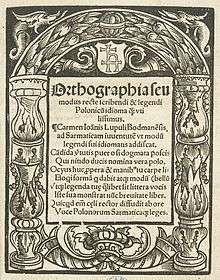History of Polish orthography
Poles adopted the Latin alphabet in the 12th century. This alphabet, however, was ill-equipped to deal with Polish phonology, particularly the palatal consonants (now written as ś, ź, ć, dź), the retroflex group (now sz, ż, and cz) as well as the nasal vowels (now written as ą, ę). Consequently, Polish spelling in the Middle Ages was highly inconsistent as writers struggled to adapt the Latin alphabet to the needs of the Polish language. There was no unified system; different writers came up with different systems before the modern Polish orthography was firmly established.

In the earliest documents the letter c could signify c, cz, or k while the letter z was used for ś, z, ź, and ż. Writers soon began to experiment with digraphs (combinations of letters), new letters (ø and ſ), and eventually diacritics.
Some examples from the Bull of Gniezno (1136) and the Holy Cross Sermons (13th-14th centuries):
| Modern | Middle Ages | Examples (with modern orthography in brackets) |
|---|---|---|
| Nasal vowels (ą, ę) | am, an, e, em, en, o, um, un, ø | Dambnizia (= Dębnica ), Chrustov (= Chrząstów), sø (= się), sa (= są) |
| ć | c, ch, cz, t | Chotan (= Chocian), cynich (= czynić), czyalo (= ciało) |
| cz | c, ch, che | Lunciz (= Łęczyca), Bichek (= Byczek), rech (= rzecz), uciny (= uczyni) |
| dz | c, cz, dz, z | Zeraz (= Sieradz), drudzi (= drudzy), doracy (= doradzi), pyenyącz (= pieniądz) |
| i | i, y | faly (= chwali), ubogy (= ubogi) |
| j | g, i, j, y | ienze, iaco (= jako), Voibor |
| k | c, ck, k | Cochan (= Kochan), Curassek (= Kurasek), ktore (= które), taco (= tako), peckle (= piekle) |
| rz | r, rz | np. Krisan (= Krzyżan), przichodzi (= przychodzi), grzechow (= grzechów) |
| s | s, ss, z | gloz (= głos), gest, sstokrocz (= stokroć) |
| ś | s, sch, ssy, sy | swyata (= świata), swyeczską (= świeczką), prossycz (= prosić), syadl (= siadł) |
| sz | s, sch, ss, sz | Calis (= Kalisz), Gneuos (= Gniewosz), schuka (= szuka), napelnysz (= napełnisz), masch (= masz) |
| t | t, th | themu (= temu), thu (= tu) |
| u | u, v | trvdnem, uznaie (= uznaje), vczil (= uczył), Bogvmil (= Bogumił) |
| w | u, v | Vsemir, vmoch (= w moc), pouaba |
| y | i, y | gdi (= gdy), przigani (= przygani), cynili (= czynili) |
| ź | sy, z, zy | zyemya (= ziemia), priiazny (= przyjaźń) |
| ż | s, z | yze (= iże), urazonego (= urażonego) |
Subsequent reforms
Many orthography reforms happened in the end of the 18th century (under the auspices of Komisja Edukacji Narodowej (Onufry Kopczyński) and during the course of the 19th century, when the modern Polish language developed differently in the three parts created after the Partition of Poland.
A major reform of Polish orthography happened in 1936, as decided by Polska Akademia Umiejętności. Lesser changes happened after 1956.
See also
- Polish orthography
- Old Polish language
- Evolution of the Polish language
- Polish phonology
- Help:IPA/Polish
Literature
- Kochanowski, Jan; Januszowski, Jan; Górnicki, Łukasz (1594). Nowy karakter polski y orthographia polska. Kraków. [a scan]
- Kochanowski, Jan; Januszowski, Jan; Górnicki, Łukasz (1594). Nowy karakter polski y orthographia polska. Kraków. [a scan in the DjVu format]
- Kochanowski, Jan; Januszowski, Jan; Górnicki, Łukasz (1594). Nowy karakter polski y orthographia polska. Kraków. [a transcription]